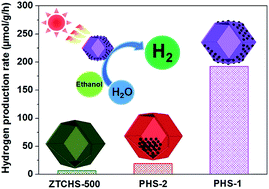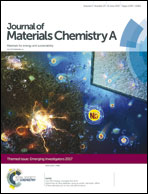Design and synthesis of porous ZnTiO3/TiO2 nanocages with heterojunctions for enhanced photocatalytic H2 production†
Abstract
Despite the tremendous potential applications of hollow micro/nanostructures, their composition has been limited to mainly single chemical compounds. Inspired by recent innovations in the areas of metal organic frameworks (MOFs) and nanocoating, here, we report the rational synthesis of mesoporous ZnTiO3/TiO2 hollow polyhedra (MZTHP) obtained by hydrothermal treatment of zeolitic imidazolate framework-8 (ZIF-8)@TiO2 core–shell polyhedral particles. The subsequent calcination of these particles caused phase transformation from TiO2 to ZnTiO3 and eventually induced the formation of Zn2TiO4. In addition, the fabrication of these hollow structures revealed a way for the preparation of hollow polyhedral photocatalysts with Pt nanoparticles deposited onto their external surface (PHS-1) or encapsulated inside their hollow structures (PHS-2). Importantly, these two types of Pt-decorated nanoparticles are shown to exhibit an improved yet distinctly different performance for photocatalytic hydrogen production, highlighting that the photocatalytic activity correlates with the Pt location and dispersion.

- This article is part of the themed collection: Journal of Materials Chemistry A Emerging Investigators


 Please wait while we load your content...
Please wait while we load your content...